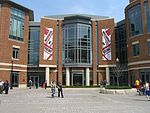John Glenn College of Public Affairs
2006 establishments in OhioColleges, schools, and departments of Ohio State UniversityEducational institutions established in 2006John GlennPublic administration schools in the United States ... and 1 more
Public policy schools

The John Glenn College of Public Affairs is a public policy and management school at Ohio State University. The Glenn College offers undergraduate, graduate and doctoral programs in public affairs. The Glenn College provides research, training and technical assistance to state, public and nonprofit organizations. The college is named after United States Senator and astronaut John Glenn. On January 30, 2015, the Ohio State University Board of Trustees approved a change of status of the former John Glenn School of Public Affairs making the new John Glenn College of Public Affairs the 15th college at The Ohio State University.
Excerpt from the Wikipedia article John Glenn College of Public Affairs (License: CC BY-SA 3.0, Authors, Images).John Glenn College of Public Affairs
College Road, Columbus
Geographical coordinates (GPS) Address Nearby Places Show on map
Geographical coordinates (GPS)
| Latitude | Longitude |
|---|---|
| N 39.99916 ° | E -83.009596 ° |
Address
Page Hall
College Road 1810
43210 Columbus
Ohio, United States
Open on Google Maps








